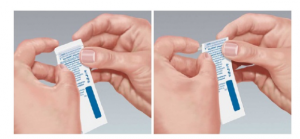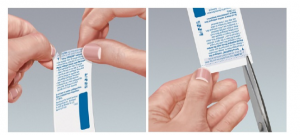ARTICLE SUMMARY: Yes, Suboxone is addictive. It is a combination of buprenorphine and naloxone. Buprenorphine is a psychoactive opioid that affects the brain and can cause euphoria. While Suboxone has low addictive potential, prescription use needs to be monitored by a professional.
TABLE OF CONTENT
- Ingredients
- Addiction Potential
- Too Much?
- How Does Addiction Occur?
- Dependence vs. Addiction
- Do I Have a Problem?
- Getting Help
- Guidelines for Correct Use
- How to Take Suboxone
Ingredients
Suboxone is an opioid partial agonist-antagonist which contains the drugs buprenorphine hydrochloride and naloxone hydrochloride. The National Institutes of Health describes this class of medication as an exception; Suboxone isnot the same as straight opiates, but acts in a similar way on the brain. In fact, it is a prescription medication that falls into a relatively strange cateogry of “opioid antagonist”.
Buprenorphine is the active ingredient in Suboxone. This opioid partial agonist-antagonists attaches to the same receptors as other opioids, and recuces their effects by blocking them.
Naloxone belongs in a class of medications called full opioid antagonists. It is added to Suboxone to prevent misuse; if people try to take high doses of Suboxone, naloxone triggers withdrawal effects.
Basically, Suboxone works by occupying the same opiate receptors in the brain as heroin and other strong opiate drugs. In this way, it is sed to stop drug cravings and withdrawal symptoms as well as block the effects of heroin (if you take it). In this way Suboxone is a medication used in medication-assisted treatment of opiate dependence and/or addiction.
Addiction Potential
Addiction to opioids is a major concern in the U.S. in 2017. The American Society of Addiction Medicine (ASAM) reported that over 2.5 million Americans deal with substance abuse disorders connected with opioid drugs, both painkillers and heroin. In 2002, as a response to this growing epidemic, the U.S Food and Drug Administration (FDA) approved two products for opioid treatment:
- Subotex, which is buprenorphine
- Suboxone, a blend of buprenorphine and naloxone
But is Suboxone as addictive as other opioids?
No, Suboxone is much less addictive than other options for treating opiate dependence (methadone). Nevertheless, this medication can still produce euphoric effect, since it acts on the same receptors that release dopamine in the brain. So, there’s possibility that you can become addicted, especially if you start abusing Suboxone. The feeling of ‘getting high’ on Suboxone may be less intense than other opioids, but it also last longer.
Drug abuse = Using Suboxone in a way other than directed by a doctor (in larger amounts, more frequently than normally taken, or chewing, crushing, snorting, or injecting buprenorpine). If you do any of these things, you are abusing Suboxone.
Because Suboxone is addictive, doctors make an effort to carefully monitor each individual’s use. They are required to; the U.S. government highly restricts buprenrophine prescription. Under the Drug Addiction Treatment Act of 2000 (DATA 2000), physicians are required to complete an eight-hour training to qualify to prescribe and dispense buprenorphine. SAMHSA lists all doctors who are certified to dose buprenorphine and you can find a Suboxone prescribing doctor here.
Am I Taking Too Much?
Are you abusing Suboxone by taking it too frequently or in larger than normal doses? If you’re taking Suboxone as directed in your prescription, you probably aren’t addicted. Factors which will make you more likely to develop an addiction include:
- Chewing or crushing Suboxone into a powder and snorting.
- Crushing Suboxone to dissolve in water and inject.
- Taking Suboxone in higher doses than prescribed.
- Taking Suboxone more frequently than prescribed.
When you are in medication-assisted treatment, you should always follow doctor’s guidelines on how to use Suboxone. Take this medication ONLY as prescribed by a doctor. If you have doubts that you are using it too much, consult with your prescribing doctor, addictions counselor, or therapist.
How Does Addiction Occur?
According to the National Institute of Drug Abuse, addiction is a chronic disease characterized by substance seeking and use that is highly compulsive, or difficult to control, despite harmful consequences. Generally, addiction occurs as a combination of environmental, psychological, and genetic factors that include:
- A personal or family history of substance abuse.
- Co-occurring mental health disorders.
- Individual metabolism and reactions to a drug.
- Traumatic events.
Substances affect the brain by stimulating receptors to release dopamine, and the person feels pleasure and ‘high’. After a period of time, the brain adjusts to the new substance environment, and starts to control the body by asking for more and more of the drug of choice. So, when a person lowers a dose of their drug-of-choice or stops taking it completely, s/he may experience withdrawal symptoms that are a sign of substance dependence.
Suboxone may be a preferred drug of abuse for people who seek an opioid-like high. It’s considered to be a more safe drug. Moreover, this medication may be abused by those who struggle with opioid drugs such as heroin, by using Suboxone between doses to stop withdrawal symptoms. Also, Suboxone abuse may be common among inmates. This 2011 New York Times expose reported that 12 % of all confiscated contrabands in state prisons in Massachusetts involved Suboxone.
Dependence vs. Addiction
You’re more likely to develop a physical dependence rather than addiction when you use Suboxone. Drug ddependence simply means that you are unable to stop using Suboxone without experiencing withdrawal effects. These effects are much more likely in someone who uses Suboxone long-term. Note here that dependence is an expected outcome! Doctors know that if you take Suboxone for a period of a few weeks or longer, you will become physically dependent.
While addiction to Suboxone is a little less common than dependence, it can involve developing a tolerance to the medication, requiring greater and greater doses to achieve the same level of pain relief. Addicts also experience strong cravings for Suboxone. Despite the negative consequences of their actions, people addicted to a drug just can’t stay quit; they come back to their drug-of-choice again and again. It is this psychological compulsion to use Suboxone in the face of negative outcomes which sets apart a Suboxone addict from a physically dependent person.
This 2011 study on buprenorphine withdrawal using gradual tapering suggests that a 7-day taper can help minimize the intensity, severity, and discomfort of buprenorphine withdrawal.
Do I Have a Problem?
While it can be hard to distinguish addiction from dependence, there are some tell-tale signs which can let you know if you’re addicted to Suboxone. If you feel the need to take Suboxone compulsively, or feel you’re unable to function normally without it, those can be signs of addiction. Other signs of Suboxone addiction include:
- Continuing to use Suboxone even with negative consequences.
- Cravings for Suboxone (sometime even after you’ve taken it recently).
- Seeking Suboxone in order to stimulate the “reward center” of the brain.
- Wanting to cut down or quit use, but not succeeding.
- Going through withdrawal when you stop using it.
- Using it to prevent withdrawal symptoms of happening.
- Taking it no matter what.
- Giving up important social, occupational or recreational activities due to Suboxone use.
Sometimes, knowing how much Suboxone is in your system can provide you with objective information about dependence levels, However, while it’s possible that Suboxone show up on a drug test, buprenorphine-specific drug screens are costly and not normally used in standard employment drug testing. So, drug testing for addiction has its limitations. Instead, we look to more subjective symptoms.
Some of the most common physical signs that a person addicted to Suboxone is likely to display include:
- apathetic mood
- depression
- drowsiness
- increased blood pressure
- poor memory
- slurred speech
- small pupils
Getting Help
STEP 1. Admit you have a problem. If you’re worried that you have a problem, chances are that you do. The road to addiction recovery starts with your decision to quit using Suboxone. Only YOU are the one that can turn your life around and start living a drug-free life. The first thing you can do is to admit that you have a problem
STEP 2. Then, commit to change. If you want to break the habit, find a reason to quit. Find a motivation that will lead you to a normal life. Educate yourself about all harmful effects that addiction can make to your life.
STEP 3. Ask for help. Finally, when you are ready for quit, reach out for help. You can start by talking with your doctor. Or, calling the helpline number listed on this page. The bottom line is: you need to talk to people to find the best treatment options that will work for you. If you stay quiet, nothing will change.
Guidelines for Correct Use
Use Suboxone only as prescribed by a doctor. Before you start using it, read the FDA’s Medication Guide to Suboxone that comes with each package. The most important information that you should know about this medication is that Suboxone can cause serious and life‐threatening breathing problems. Call your doctor or 911 if:
- you feel dizzy, faint, or confused
- your breathing gets much slower
Plus, you need to know that Suboxone:
- Can cause allergic reaction.
- Can react with other medications.
- Contains an opioid that can cause physical dependence.
- Should never be injected.
Finally, be honest with your prescribing doctor. Tell your doctor about your full medical history. Then, do not change your dose unless your doctor tells you to change it. And do not take Suboxone more often than prescribed.
NOTE: The Medication Guide doesn’t take the place of consulting with your doctor. Talk with your doctor is you have questions about Suboxone.
How to Take Suboxone
Since Suboxone comes as sublingual film you need to be careful every time you use it. Each Suboxone sublingual film comes in a sealed child‐resistant foil pouch. Wait to open it until right before you use it. Below are instruction on how to use Suboxone correctly.
1. To open your Suboxone sublingual film foil pouch, fold along the dotted line:
2. Tear down at the slit or cut with scissors along the arrow:
3. Hold the film between two fingers by the outside edges.
4. Place Suboxone sublingual film under your tongue, close to the base either to the left or right of the center.
5. While Suboxone is dissolving, do not chew or swallow the film because the medicine will not work as well.
Your Questions Are Welcomed
Do you still have questions about Suboxone and its addictive potential? Please leave them here. We are happy to help answer your questions personally and promptly. If we do not know the answer to your particular question, we will refer you to someone who does.













Related Posts